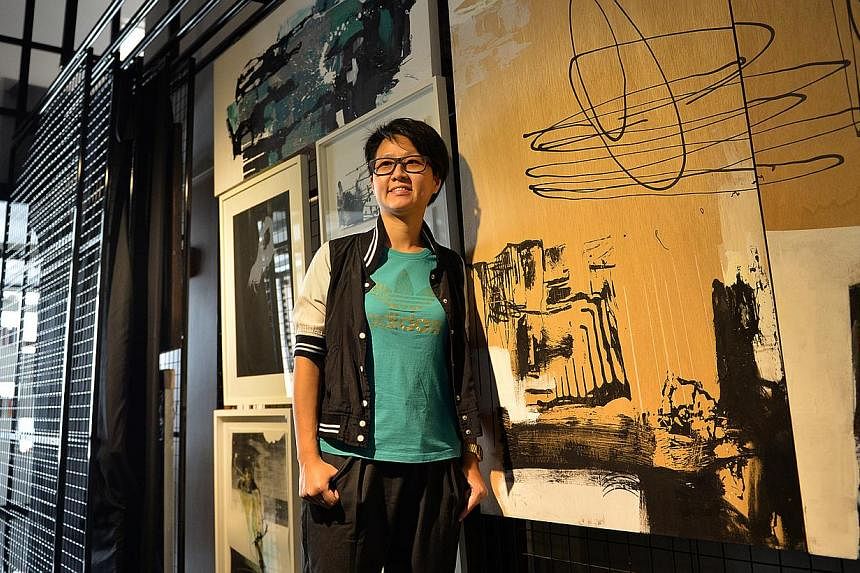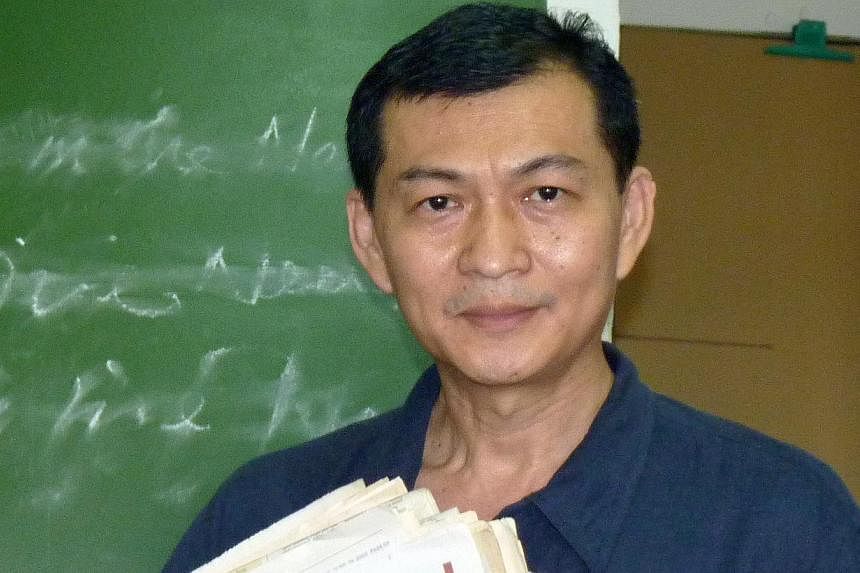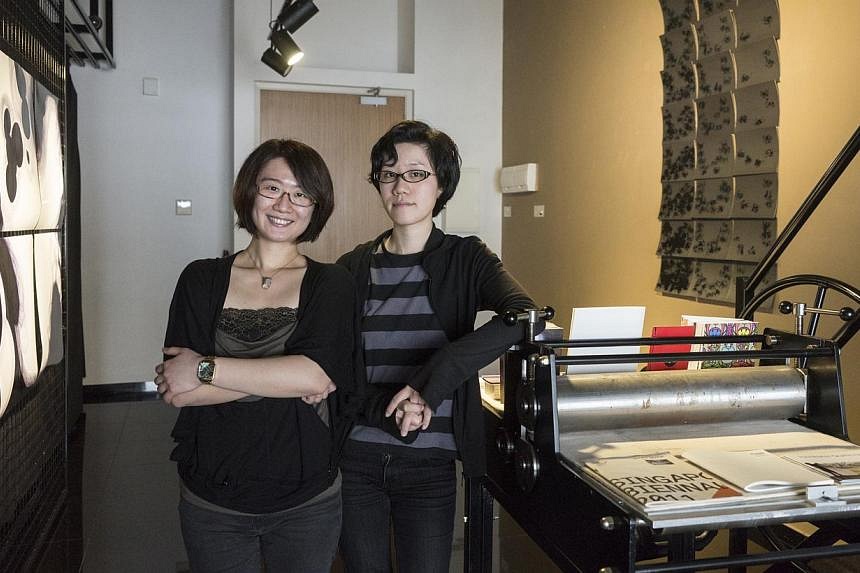At the Museum of Modern Art in New York, a work of art made in Singapore greets thousands of international visitors as they pass through the doors of the renowned arts institution every day.
Hanging in the museum lobby is an eight-panel piece, Spice Moons, by the prominent Korean artist Haegue Yang.
The work was made during the artist's residency in Singapore at the STPI art centre in 2012 and last year. It comprises 160 prints on sandpaper that incorporate herbs and spices common to this part of the world, including white pepper and star anise.
STPI director Emi Eu, 45, says: "It's really clear that this project was inspired by Singapore, its multi-ethnic experience, and Yang's sojourn with our workshop team, which supports our artist- in-residence."
She adds that the coup recognises the artist as well as the contribution made by Singapore and the STPI residency to the international arts scene.
Residency programmes typically provide artists with a dedicated space and a stipend, for a period of time, to focus on their practice without being distracted by livelihood and day-to-day obligations. And often, the liberating experience inspires artists to come up with fresh works.
In Singapore, there are no fewer than 14 artist residencies, many begun in recent years as the arts scene matured and more arts spaces opened. The programmes support both local and foreign artists working in various disciplines, including dance and the literary and visual arts.
The growth in residencies here - whether at arts venues or in universities - has led to greater artistic research and creative output. And this in turn, has injected new ideas into the arts scene and made Singapore an emerging incubator of art in the world.
While residencies here vary in structure, offerings and aims - some are by-invite only, a few provide accommodation and a stipend, and several eschew having a specific outcome such as a show - they are unanimous in pushing the development of art and the artists.
STPI, which specialises in paper- and print- making, tends to invite artists who are less familiar with these mediums for its residency, which started in 2002.
The aim - to get artists to surpass themselves.
The result - often "ground-breaking, innovative" work produced in collaboration with the centre's 14-person workshop team, says STPI's Ms Eu.
An example is famed Korean artist Do Ho Suh, who is well known for his fabric installations. He came up with a new, acclaimed series of work, drawings sewn with thread on paper, during his residency at STPI in 2010.
Suh, 51, who recently returned for another residency at STPI to further develop his thread drawings, says: "I first took up the residency a few years ago because it allowed me to leave my comfort zone, put myself in a situation and develop something completely new. And STPI really encouraged me to try different things; that was how the whole body of thread drawings came about."
He adds of his return to STPI: "Because it started here, the thread drawings can't be separated from STPI and there are not that many paper workshops in the world that do what they do."
His new thread drawings, which are more ambitious in size and colour, will be presented at the centre in a solo show planned for next year.
The artist residency at Odyssey Dance Theatre is similarly a vital breeding ground for experimental work and the development of the home-grown dance company. Its residency programme, launched in 2004 and held once every two years, invites dancers and choreographers overseas to work with the company for a few months.
This year, prominent Korean choreographer Park Na Hoon and his namesake dance company participated in the residency.
Odyssey Dance Theatre's artistic director Danny Tan, 42, says its residency puts the artists in a different frame of mind, one that urges them "to take time and take the risk to come up with work that will support artistic development in the long run", instead of merely popular works for the present.
It helps that most residencies here receive some form of funding from patrons or government grants to support artists in their pursuit of creative whim.
But there are exceptions, such as the self-funded residency at Instinc. It is an arts space with locations in Clarke Quay and Bukit Batok Crescent, ownedby Singapore artist Yeo Shih Yun.
Yeo, 38, who has participated in several artist residencies in Europe and Asia, says she was inspired to start one herself in 2009 following the example of her friend, Japanese artist Hirofumi Matsuzaki, who initiated a residency in Fukuoka.
To cover the cost of the residency, Instinc charges the artist $3,500 for use of the studio, accommodation - a loft in Clarke Quay - and the organisation of an exhibition; the artist does not receive a stipend. Having to pay a fee has not dampened its appeal. The residency has received 38 artists, including painters, poets and musicians, from 20 countries such as Brazil, Slovenia and Japan.
Among them is Mexican artist Natalia Ludmila, 33, who says she applied for a residency at Instinc in 2012 because she was fascinated by what she had read of Singapore and wanted to visit. And as with many of the artists-in-residence at Instinc, she applied for funding from the arts council in her home country to pay the residency fee.
Artist residencies, however, benefit more than just the artists and the artistic reputation of Singapore. Ordinary Singaporeans too get to enjoy the fruits of these programmes.
The Substation, which started its residency in 2011, invites artists here to conduct community- based research during their residency. This push, says programme manager Chris Ong, 37, "has enabled artists to pursue projects that bring attention to under-represented communities and social issues".
An example he cites is dancer-choreographer Ming Poon, who came up with a performance piece based on interviews he conducted during his residency with people living with HIV in Singapore.
The public is similarly enriched by the residency programme at the Centre for Contemporary Art, an exhibition and research venue run by the Nanyang Technological University (NTU) in Gillman Barracks. Launched in July, the programme's artists-in- residence hold regular talks and open studio sessions for the public.
Artist Koh Nguang How who is in residence at the centre, for example, has opened up his extensive archive of photographs, posters and publications related to Singapore's art history. His showcase at the centre's artist studio in Gillman Barracks since October has so far attracted about 3,500 visitors.
At the National University of Singapore (NUS) College of Alice and Peter Tan, the artist-in- residence is expected to mentor students and conduct workshops for the college community, says a university spokesman. The residency at the college began in 2012.
Third-year NUS student Vincent Tan, who has attended workshops held by the current artist-in- residence at the college, documentary photographer Edwin Koo, likens the experience to "having a big brother take you through unfamiliar passages of photography".
The wide-ranging benefits of artist residencies have only strengthened their presence here.
The writing residency at NTU, launched in 2011 in collaboration with the National Arts Council, was initially scheduled to run for three years. But the positive feedback from its writers-in-residence, who include acclaimed Chinese novelist Su Tong and award-winning poet Yong Shu Hoong, as well as from students mentored by the writers, has led to the extension of the programme, says the chair of NTU's School of Humanities and Social Sciences, Professor Liu Hong. The residency will now run for a further three years until 2017.
The residency programme at home-grown arts space Grey Projects in Tiong Bahru is also marking a milestone. Founded by Singapore artist-writer Jason Wee, 36, the programme sends Singapore artists on an exchange to partner residencies overseas, and it will celebrate its fifth anniversary next year with the publication of a book. It will also partner new residencies in Colombia and Taiwan for the programme next year.
However, Wee says: "The measure of success, if there is to be one, is not in the immediate outcome of a short stint, but in the changes months after. We've sent artists Kelvin Atmadibrata, Geraldine Kang and Kray Chen among others on the residency and we're very proud of how they have developed since."







